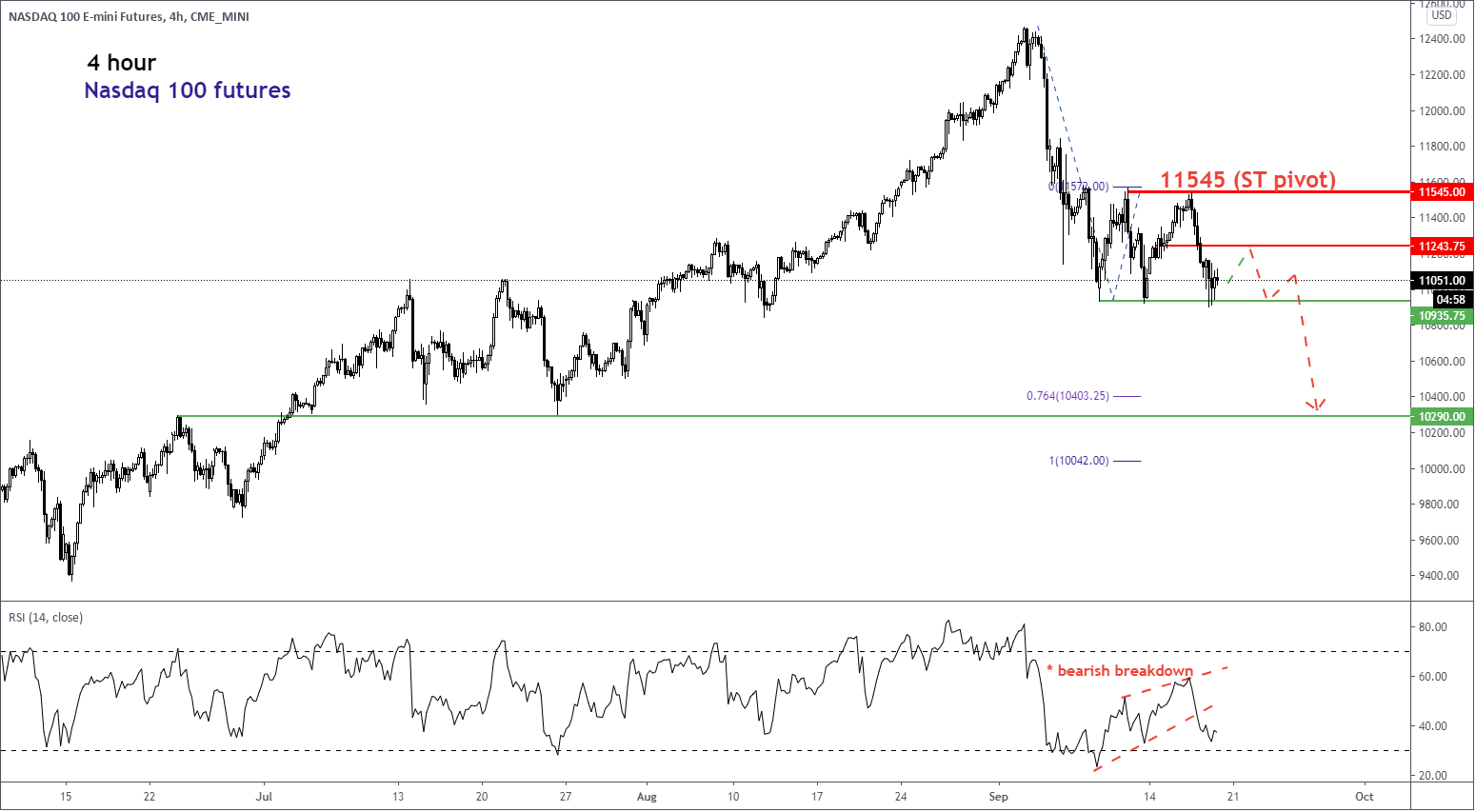
US stock markets continued to display weakness as both the benchmark indices S&P 500 and Nasdaq 100 closed lower for the second consecutive trading session since Wednesday.
The Nasdaq 100 had declined by -1.48% where its underperformance against the S&P 500 (-0.84%) had been dragged down by mega technology stocks such as Facebook (-3.30%), Amazon (-2.25%), Apple (-1.60%) and Microsoft (-1.04%). Meanwhile, a bright spot was seen in U.S. material related stocks where the S&P Materials sector ETF had outperformed the broader market and recorded a gain of 0.74%.
Over at the foreign exchange market, the GBP/USD was one of the more volatile major pair as it had seen a spike down of 116 pips to print an intraday low of 1.2863 seen yesterday after a dovish guidance monetary policy from the Bank of England (BoE). In yesterday’s BoE monetary policy meeting, officials had hinted that the central bank is comfortable to implement negative interest rates going forward. A change of fortune occurred to the GBP/USD thereafter at the start of yesterday’s U.S. session where its prior loss against the USD had been recouped shortly thereafter due to a positive Brexit related news flow; EU official Von Der Leyen had been quoted by FT that “EU-UK trade deal is still possible”.
Looking ahead
Japan inflation data for August where expectation has indicated a resurgence of deflationary pressure since April 2020. Consensus for the national core CPI is set at -0.4% year-on-year after two consecutive months of zero inflationary growth for May and July. The inflation data was within expectation as seen in today’s release during early Asian session. Interestingly, it will be worth to monitor the movement of USD/JPY as it has continued to evolve in a short-term downtrend since 28 August 2020. The current movement of the USD/JPY seems to be driven by external potential risk events such as the post FOMC’s sell-off seen in U.S. stocks and the upcoming U.S. presidential election rather than domestic factors such as the newly elected Prime Minister Yoshihde Suga who will likely carry forward the policies of the former Abe administration that tends to favour a weaker Japanese yen.
USD/JPY - Intermediate short-term support zone rests at 104.40/20 where a daily close below 104.20 may open up scope for a further potential drop to retest the 102.00 psychological level which is also the 09/10 March 2020 swing low area.
UK retail sales; market participants are expecting a reading of 0.7% month-on-month for August, a slowdown in growth from 3.6% month-on-month seen in the previous month. Hence, U.K. consumers spending habits are being put to the test whether the previous three months of growth since May 2020 are sustainable. A weaker retail sales data may add impetus for the Bank of England (BoE) to introduce more quantitative easing measures in the next monetary policy meeting. A more dovish oriented BoE may weaken the GBP/USD further on top of the current squabbles between U.K. and EU officials over the Brexit trade deal negotiation.
US quarterly options expiration ("quadruple witching") where stock index futures, stock futures, stock index options and stock options expire together that tends to result in an increase in volatility if the U.S. stock indices have started to move in a corrective phase, occurring at that time.
Chart of the day: Nasdaq 100 futures
Nasdaq 100 - The highly volatile growth-oriented Nasdaq 100 futures has started to move downwards after a failure to break above a range resistance of 11,510 in place since 10 September 2020 and it is now looking to challenge a 2-week range support of 10950. A break below 10,935 may unleash another round of corrective down move to target the next support zone at 10290/10040.

Disclaimer: CMC Markets is an execution-only service provider. The material (whether or not it states any opinions) is for general information purposes only, and does not take into account your personal circumstances or objectives. Nothing in this material is (or should be considered to be) financial, investment or other advice on which reliance should be placed. No opinion given in the material constitutes a recommendation by CMC Markets or the author that any particular investment, security, transaction or investment strategy is suitable for any specific person. The material has not been prepared in accordance with legal requirements designed to promote the independence of investment research. Although we are not specifically prevented from dealing before providing this material, we do not seek to take advantage of the material prior to its dissemination.





















